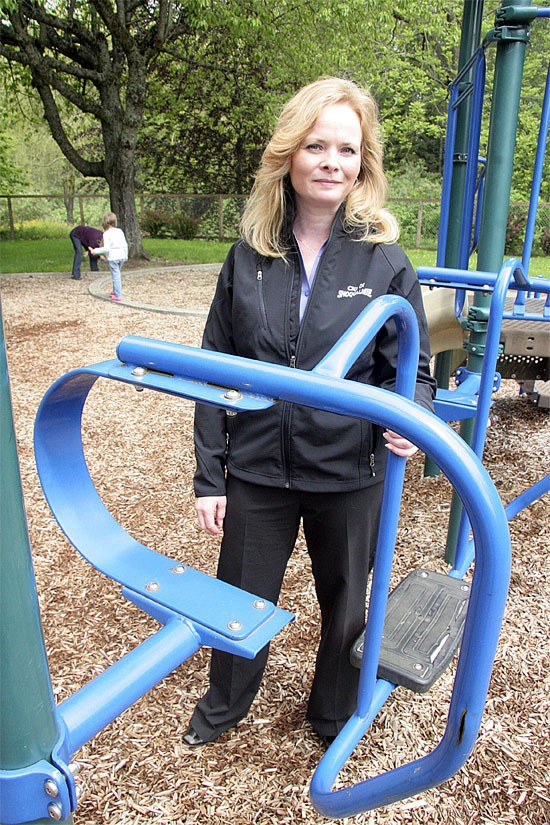Snoqualmie’s Northern Street isn’t much to look at — and that’s fine with retiree Robert Hoover.
“I don’t want a big change,” said Hoover, who has lived on Northern since 1970, when the neighborhood was part of King County. Today, his home is in city limits, and the street out front is one of Snoqualmie’s worst roads.
The pavement is failing, and extensive “alligator” cracks — so called because they resemble a reptile’s scaly back — stretch for blocks. Fixing Northern Street is just one of a laundry list of infrastructure repairs that Snoqualmie will have to tackle over the next decade. But several residents, including Hoover, balk at major changes or a steep price tag.
“Who are they going to stick?” Hoover asked. “An old guy like me who hasn’t had a raise in 20 years?”
Hoover hates the idea of a street widening project biting into his driveway and eating up part of his front yard. Neighbor Joanie Moore feels the same way.
“A lot of people have incorporated their yard into the median,” Moore said. “That would be a lot of disruption.”
Northern Street resident Linda Johnson said a lot of walkers, joggers and cyclists use the road, and children play in the street. Car traffic is minimal. A full-on urban street with sidewalks would change the dynamic.
“I don’t want anything that would make our place look like the Ridge,” Moore said.
Town hall
The future of places like Northern Street — and how much attention should be given to deteriorating city infrastructure — is an ongoing topic at this summer’s Snoqualmie Town Hall meetings. The third and final meeting and social is planned for 6:30 p.m. Wednesday, June 30, at Cascade View Elementary School.
The city cares for 35 parks, 42 miles of street, 72 miles of sidewalk, two water plants and a wastewater treatment facility.
Many of those parks and roads were added in the past decade, a time when Snoqualmie was Washington’s fastest growing city. Now, those streets and parks are coming up on their first major repair and replacement cycle, potentially costing the city as much as $4 million per year.
During early town hall meetings, Snoqualmie Public Works Director Dan Marcinko asked residents to grade infrastructure both downtown and on the Ridge. Scores dipped after he showed residents photos of cracked streets and fire hydrants dating to 1928.
Snoqualmie Parks Director Gwen Voelpel showed images of 10-year-old Community Park.
“At a distance, Community Park looks pretty nice,” she said. “But get a little closer, and you can see that already, the park is showing some wear and tear.”
Cracked sidewalks, deteriorating athletic fields, rusting trash cans and vandal-prone restrooms are all signs of age. Dozens of Community Park fixes over the next 20 years, from new bathroom fixtures in 2016 to new sport courts in 2030, add up to $2.4 million.
Downtown, the city’s Riverview Park also looks fine on the surface. But Voelpel pointed to cracked and sun-worn play equipment and a rotting wood drinking fountain.
“We’ve got to think about how we’re going to tend to this stuff on our own,” Snoqualmie Mayor Matt Larson said. “There is a significant cost of delay. There are too many cities who ignore the problem and hope it goes away.
“We’re looking ahead and saying ‘what is the full scope of this issue, and how can we get a handle on it?’” he added. “An ounce of prevention is worth a pound of cure.”
Paying for it
The city’s fiscal toolbox includes property tax increases, utility fee increases, city bonds, car tab fees and a Local Improvement District, or LID. Snoqualmie is currently considering a $20 car tab fee to pay for street repairs and maintenance.
During the meetings, Larson polled residents on how much they would be willing to pay for infrastructure repairs. Most respondents at the early June meetings said they could support a tax increase of $30 to $45 per month, and supported a mixture of city-wide tax increases and local improvement districts.
One option to pay for fixes is modifying or eliminating projects. Northern Street was discussed as an example, where the city would skip the expense of adding new sidewalks and street trees.
Northern Street residents themselves differ on whether their street is an urban or rural place, and whether it should get urban features.
Johnson said she feels the neighborhood is an urban place. She said a $20 car tab fee might be doable, but was among neighbors who complained about taxes failing to keep pace with wages.
Next door, Moore welcomes more street trees and flood protection. That said, she doesn’t want big changes.
“I like the way our street is.”



